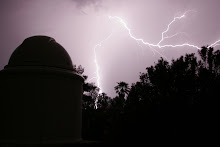
I'm freezing right now but I'm totally enjoying my 5th observing night here at TSP. It's 38 degrees and breezy, and at about 3:30 a.m.
After a lecture about the LIGO gravitational wave project earlier this evening, they had some door prizes. Larry won some heavy brick things to put under tripod legs, but no luck for me. I was pretty excited to see the clear sky afterward though,
On the way to set up I noticed the 32 hour old moon setting in the West. Shortly after twilight, the zodiacal light was shining brightly. I started off with a visual observation of Castor A&B, then synched up on Arcturus. After that I moved to M3, one of my favorite globular clusters.
Wayne, Larry and I then visited the guys with the "AstroLift" system, a telescope mounted in a GMC Envoy. I've posted a blog about this system previously when they visited Starizona in Tucson. They were showing some awesome displays of objects like Omega Centauri (NGC 5139) and M104. the Sombrero Galaxy.
I then came back and decided to try some imaging again. I stayed with M3 and took images for a few hours. At one point, some nasty black clouds showed up and I thought we were in trouble, but they moved on so I was able to get plenty of data. Right now I'm continuing imaging with M17, the Swan Nebula.
During the time I was imaging, I decided to work on the Challenge binocular list. I observed the following objects through either 6.5x44 or 15x70 binoculars (actually in most cases, in both):
-NGC 2903 galaxy
-NGC 3115 galaxy
-M96 (NGC 3368) galaxy
-NGC 3521 galaxy
-M65 (NGC 3623) galaxy
-M66 (NGC 3627) galaxy
-M106 (NGC 4258) galaxy
The Milky Way is really stunning. There is a whole lot of mottled structure visible with the naked eye and there are several rifts easily seen.
We finally got a clear sky to the South in the early a.m., so I was able to locate Be 157, the last object I needed to complete the "Eye on the Sky" program.
It's really getting breezy so I expect the Swan images won't be too good.
By the way I took the star trail picture above on a digital camera from our observing site this evening here at TSP. It is a 1 hour exposure and is centered near the North celestial pole. The bright star near the center is Polaris (alpha Ursae Minor).

No comments:
Post a Comment